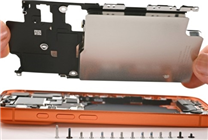**Summary Points:**
- The iPhone 17 Pro introduces an innovative heat-efficient cooling system for enhanced performance.
- Design flaws, including a susceptibility to scratching, have been identified during a recent disassembly analysis.
- A new battery tray design improves serviceability but adds complexity to USB-C interface repairs.
Recently, a thorough analysis and disassembly of the iPhone 17 Pro were conducted, unveiling significant advancements in its design and functionality. This examination highlights both the innovative cooling technology implemented in the device and certain design flaws that may impact user experience.
For the first time, the iPhone 17 Pro integrates a heat-efficient plate cooling system, significantly boosting its heat dissipation capabilities. This new thermal enhancement revolves around the principle of liquid evaporation and condensation, directly channeling heat away from the A19 Pro chip. Preliminary thermal imaging tests indicate that the iPhone 17 Pro effectively prevents overheating issues that plagued previous models during prolonged high-load operations.
However, an alarming concern has emerged regarding the device’s exterior durability. Users have frequently reported that the back cover of the iPhone 17 Pro is susceptible to scratches. Upon close inspection, experts discovered that the design flaws stem from sharp, unclipped corners where the oxide layer can deteriorate easily due to inadequate support from the core aluminum structure. This phenomenon not only leads to unsightly surface scratches but can also cause significant aesthetic damage, as flakes of the oxide layer may detach entirely, exposing the metal beneath.
In examining the implications of these findings, it becomes evident that the design choice comes with a trade-off. While the innovative materials contribute to the device’s sleek appearance, they also raise concerns regarding long-term wear and tear. Users should be cognizant of these aspects when choosing how they handle and protect their iPhones.
On a more positive note, modifications to the phone’s internal structure improve its serviceability. The iPhone 17 Pro features a newly designed battery tray, secured by 14 Torx Plus screws, employing electrolytic adhesives. This marks a step toward enhancing repair efficiency, particularly when it comes to battery replacement. However, this advancement is somewhat tempered by the elimination of the dual entrance design, which could lead to more complicated repairs. The 22-screw structure associated with the USB-C interface also serves to increase the complexity repair technicians may face when servicing the device.
In conclusion, while the iPhone 17 Pro showcases remarkable advancements in cooling technology and user serviceability, its design is not without notable flaws. Users seeking to maximize the longevity and aesthetics of their devices should consider protective measures to mitigate the scratching issues. Furthermore, an understanding of the complexities involved in repairs will be crucial for those who prioritize a hassle-free service experience.








